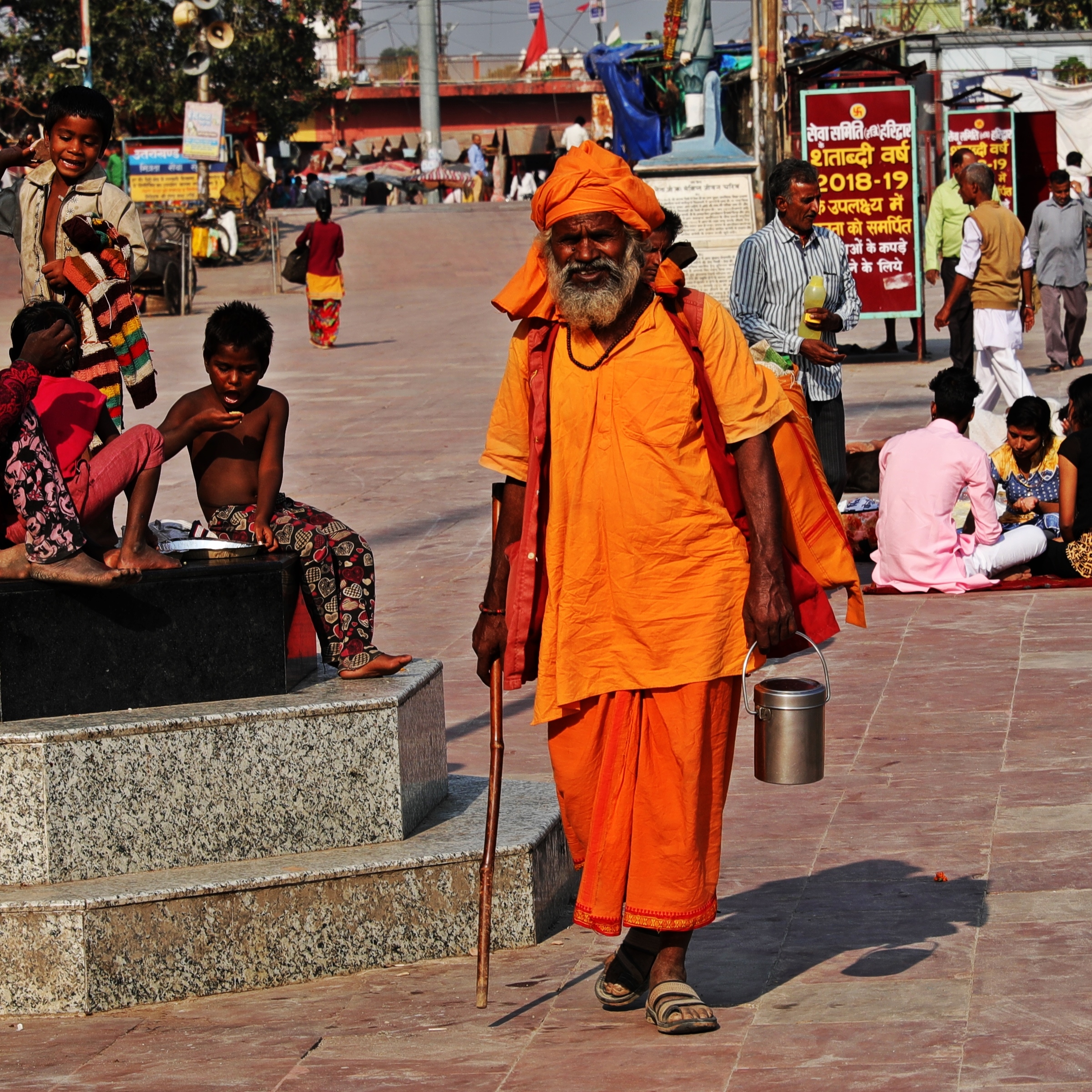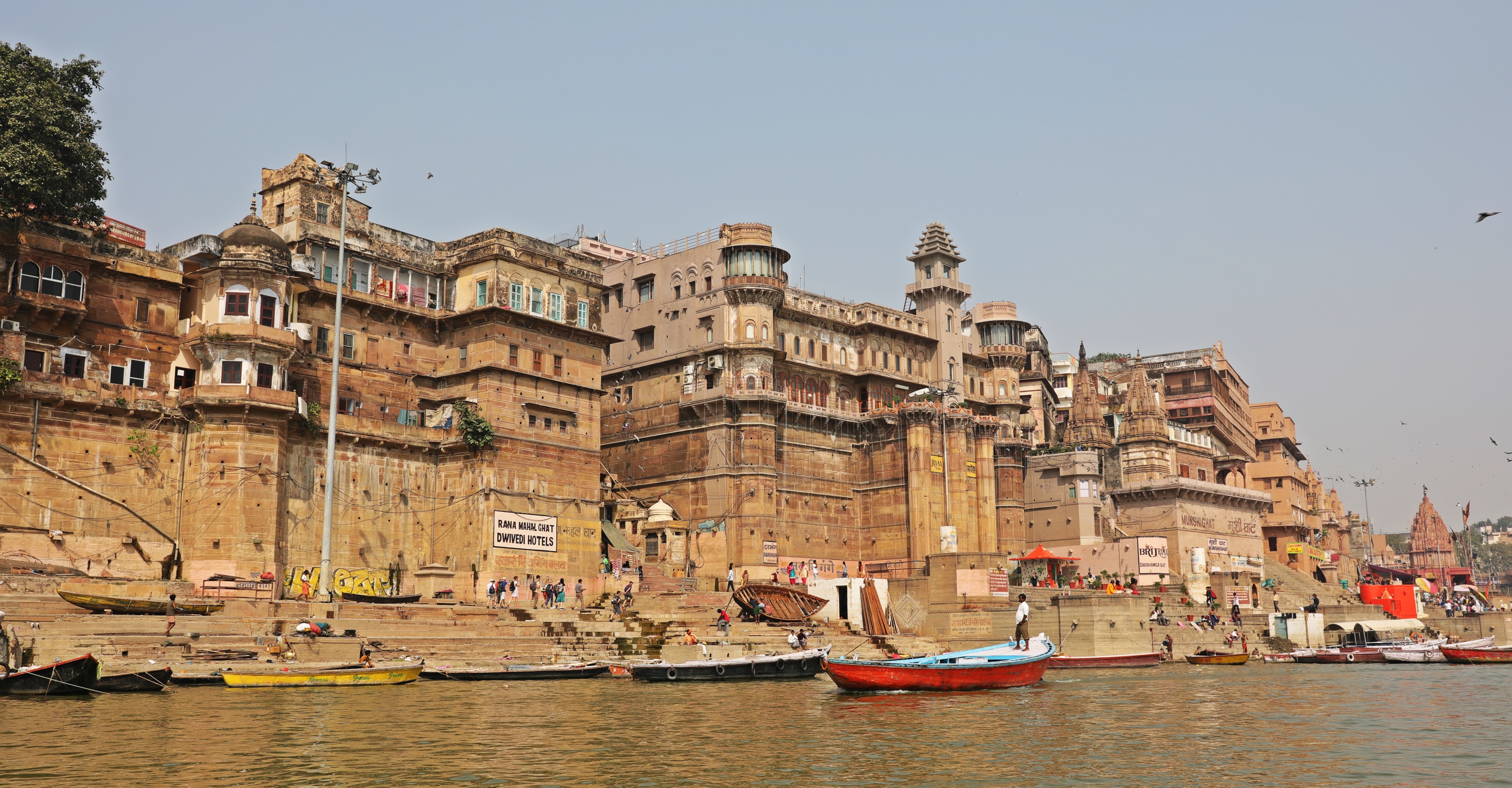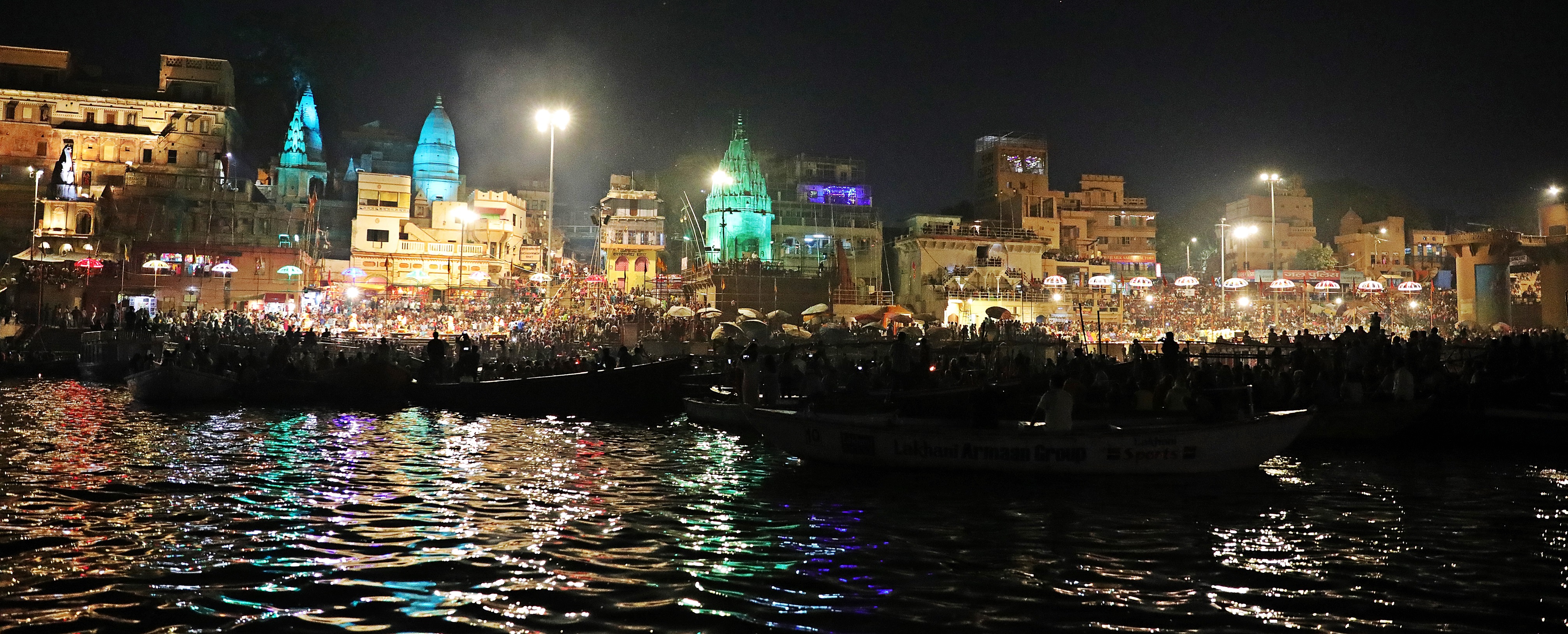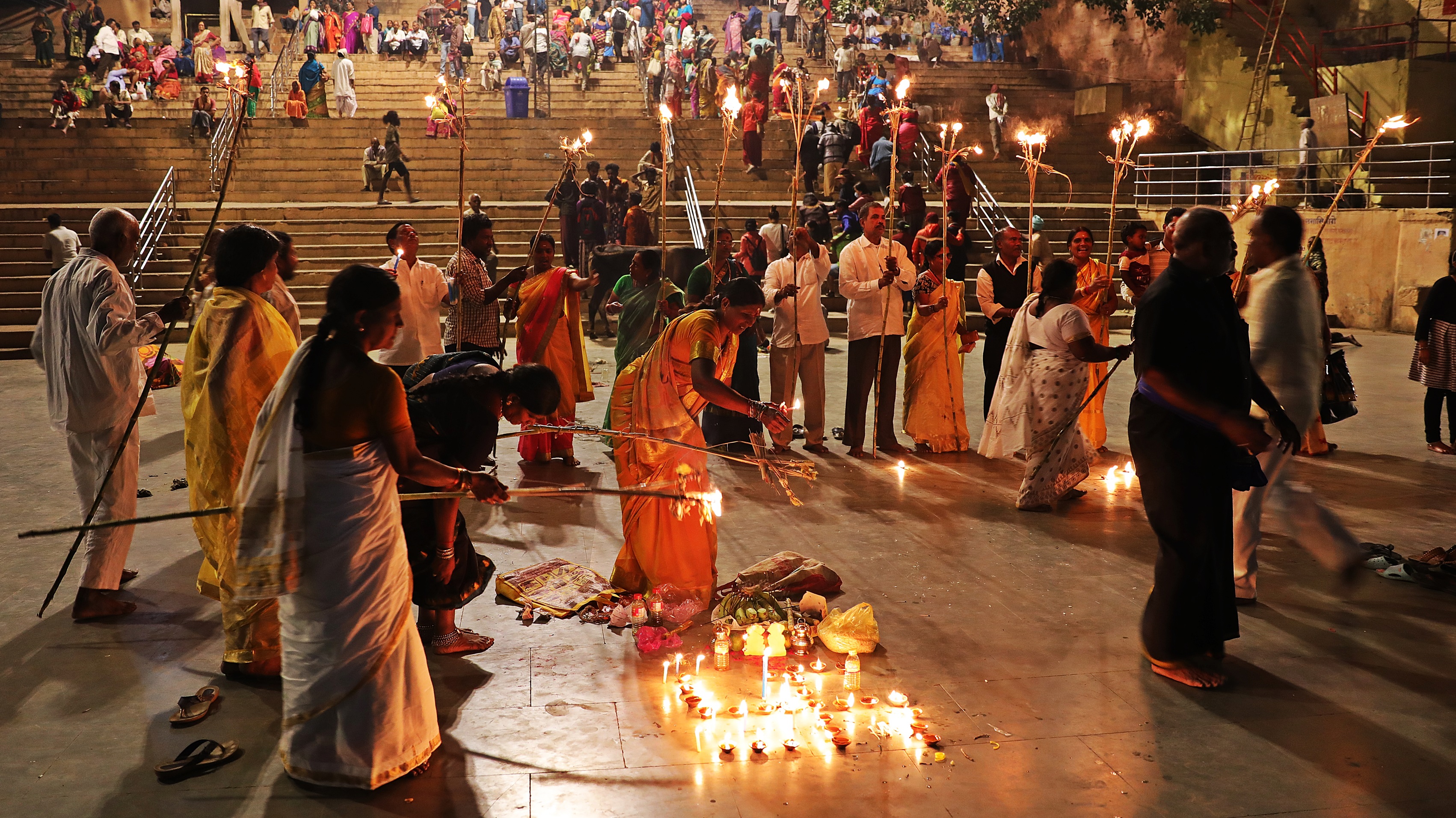After visiting the source of the Ganges River at Gaumukh Glacier and seeing pilgrims bathe in it in Rishikesh, we went further south along the Ganges to the holy cities of Haridwar and Varanasi.
Haridwar is located where the Ganges leaves the mountains and enters the plains. One of the legends of Haridwar is that a drop of the nectar of immortality fell here making it one of the holiest places along the Ganges.We saw more pilgrims in Haridwar than we have seen at the other Ganges sites.

Bathing in the Ganges 
Bathing in the Ganges, Haridwar
Many pilgrims come to Haridwar to bathe in the Ganges, washing away their sins. There many ghats (steps) leading to the river giving many different places for people to bathe. On the side of the ghats are temples and old warehouse buildings. At the main Ghat, Har-ki-Pairi, there is a small man-made peninsula and a few pedestrian bridges. The Ganges is dammed, just before Haridwar so the water levels can vary daily. When the level is low, many people pan the river looking for anything of value dropped by bathers in the previous days. Some people had amassed large plates full of jewelry and coins.

Har-ki-Pairi Ghat, Haridwar 
Panning for valuables in the Ganges in Haridwar 
Panning for valuables in the Ganges in Haridwar

Hindu Temple and the Ganges, Haridwar 
Ghats on the Ganges, Haridwar
In the middle of the river is a statue of Ganga with a large Shiva in a park on the other side. On the walk to the park are hundreds of Shiva Lingas. These are small statues with a tall, phallus coming out of a lipped disc. They are symbols of the God Shiva and the Goddess Shakti symbolizing the union of feminine and masculine values … but are supposedly not sexual.

Ganga and Shiva on the Ganges, Haridwar 
Shiva on the Ganges, Haridwar 
Shiva, Haridwar 
Shiva linga along the Ganges, Haridwar
Ganga Aarti in Haridwar is a spectacular show. Pundits, Hindu priests, lead the ritual puja in front of a crowd of thousands gathered at Har-ki-Pairi Ghat. The Pundits are dressed in red robes for the ceremony. First,they recite prayers and sing on the steps of the Ganges while hundreds of pilgrims set diyas in the water. Diyas are small baskets with flowers and a butter candle which is blessed either for themselves or in the name of a deceased loved one. These offerings are said to help achieve moksha.

Diyas for sale 
Diyas in the Ganges 
Pundits, Ganga Aarti, Haridwar 
Crowd raising their arms, responding to the pundit’s prayers 
Putting a diya in the Ganges, Haridwar 
Putting diys in the Ganges at Ganga Aarti, Haridwar
The pundits light candelabras and then brass lamps, and move rhythmically with them to hymns. Their lights and those of spectators reflect off the Ganges giving it a magical atmosphere. It’s a beautiful display of devotion.

Ganga Aarti,Haridwar 
Pundits with fire lamps, Ganga Aarti,Haridwar 
Putting diyas in the Ganges, Ganga Aarti, Haridwar 
The lights of Ganga Aarti, Haridwar 
The lights of Ganga Aarti, Haridwar
In Haridwar, Old Town is a busy market area. Many shops sell plastic bottles to collect Ganges water, figurines of Shiva, Ganga and other Hindu deities as well as shawls, saris and household items. Walking through the market at night was like being in a mall in Canada on Boxing Day.

Haridwar market

Street food vendor, Haridwar 
Street side restaurant, Haridwar 
Sadhus in Haridwar 
Market, Haridwar
There are many interesting characters in Haridwar. Everything from Sadhus to street side barbers giving customers a shave and women doing their laundry in the holy Ganges. And of course there are many street cows wandering the streets and sidewalks, eating street-food and dropping plenty of dung.

Sadhu in Haridwar 
Buffalo cart in downtown Haridwar traffic 
Street-side barber giving man a shave, Haridwar 
Street cow in Haridwar 
Sadhu in Haridwar

Laundry day along the Ganges in Haridwar
On a hill above town is the Mansa Devi Temple. When we visited, the temple was very crowded as people wanted to worship the wish-fulfilling goddess, Mansa. Inside is a small room with a statue of the goddess in the middle and pundits sitting beside it giving blessings. We tried to stay to the outside as we just wanted to observe, but one pundit made us come closer. He grabbed our heads and brought them to touch the goddess while we each made a wish. Then he asked for a compulsory donation … just like everywhere else in India. My wish was that he would stop touching my head. It seemed like such a contradiction to see the these people pushing and shoving to be blessed.

Mansa Devi Temple,Haridwar 
Mansa Devi Temple 
Getting blessed in the Mansa Devi Temple
The final holy city on the Ganges that we visited was Varanasi. The city’s history dates to BC times and is one of the world’s oldest,continuously inhabited cities. Today, this city is loud, crowded, smelly, and polluted. Old Town Varanasi is a maze of narrow alleys leading off in all directions. The buildings are quite run-down but are still used as shops,restaurants and apartments.

Old Town Varanasi 
Old Town Varanasi

Pundit, Varanasi 
Pundits, Varanasi
Varanasi has many Hindu legends associated with it. One legend says it is the location where Shiva released Ganga from a knot in his hair. As a result, it is considered one of the holiest places in all of India. There is a 2 ½ km tiled walkway along the banks of the Ganges with many ghats (steps) to the river. The buildings beside the walkway range from grand, old palaces and historical temples to old run-down warehouses and apartment buildings.

Historical buildings along the Ganges, Varanasi 
Ghats on the Ganges, Varanasi 
Ghats along the Ganges, Varanasi 
Historical buildings along the Ganges, Varanasi
There are many boatmen giving rides on the river. From the boat we had a good look at the interesting river front, both in the morning and at night.

Historical buildings along the Ganges, Varanasi 
Ghats along the Ganges, Varanasi 
Historical buildings along the Ganges, Varanasi 
Ghats on the Ganges, Varanasi 
Ganges River bank in Varanasi

Varanasi at night with Dewali lights 
Varanasi at night with Dewali lights 
Varanasi at night
Walking along this walkway is a great place to people watch. There are many characters hanging out; sadhus, bathers, people doing laundry, boatmen, pilgrims, cows but unfortunately also many beggars.

Sadhu, Varanasi 
Sadhu, Varanasi 
Street cows, Varanasi 
Sadhus, Varanasi

Laundry day on the Ganges, Varanasi
Because it is very holy, pilgrims come not only to bathe in the Ganges, but also to die and to cremate their loved ones. It is believed that dying in Varanasi assures you of moksha – a liberation from the cycle of life, death and rebirth so they will remain in heaven and not be reincarnated. Both bathing and being cremated with your ashes scattered in the Ganges, help to wash away your sins and aids in attaining moksha. There are two large open-air cremation ghats on the riverbank. All day long you can see flames from the multiple funeral pyres at these sites. Near the crematoriums are huge piles of cut wood ready for sale. Weigh scales are near-by to know the price to charge families for the cremation wood. For the funeral, bodies are covered in linen and carried on a bamboo stretcher through Old Town on the way to one of the crematoriums. There is a long procession of family members walking behind. We saw 4 or 5 when we were there.

Cremation Ghat in Varanasi 
Cremation Ghat in Varanasi 
Cremation Ghat in Varanasi 
Cremation Ghat in Varanasi 
Wood piles outside crematorium 
Weighing wood for cremation

Cremation, Varanasi

Cremation Ghat, Varanasi 
Cremation Ghat, Varanasi
Ganga Aarti pujas are performed every morning and evening at various ghats along the Ganges. They all use similar choreography with 5 – 7 pundits (Hindu priests) on small platforms performing ritualistic movements with bells, conch shells, incense, candelabras and brass lamp with a snake hood. Tens of thousands of spectators watch from shore and from wooden boats on the river. It’s a more elaborate performance in Varanasi than in Haridwar, but the large crowd and placement further from the river took away from its mysticism.

Pundits choreography with incense, Ganga Aarti, Varanasi 
Spectators at Ganga Aarti, Varanasi 
Pundits choreography with smoke, Ganga Aarti, Varanasi 
Pundits choreography with candelabras, Ganga Aarti, Varanasi 
Spectators for Ganga Aarti, Varanasi 
Pundits lighting lam;ps, Ganga Aarti, Varanasi 
Pundits with fire lamps, Ganga Aarti, Varanasi 
Pundits with fire lanterns, Ganga Aarti, Varanasi 
Pundits twirling peacock feathers, Ganga Aarti, Varanasi

Spectators at Ganga Aarti, Varanasi

Spectators on boats watching Ganga Aarti in Varanasi 
Spectators on boats watching Ganga Aarti in Varanasi
A very important Hindu celebration, Dewali, was occurring when we were in Varanasi. Dewali symbolizes the spiritual victory of light over darkness, good over evil. It is often called the festival of lights because light is an important part of the celebration. Homes and businesses drape Christmas-style lights from their roofs, small butter candles are set at ghats and in homes, many fireworks are regularly set off. During the day we saw the equivalent of Christmas Eve’s last-minute shopping. Temporary stalls lined the main streets selling butter lamps, string lights and other decorations. Sweets shops were fully stocked. Families celebrate in their homes by visiting relatives, having a large meal and giving gifts of sweets. There were a lot of people outside in the evening. They were setting off crackers and fireworks or walking along the river wishing passers by ‘Happy Diwali’. It was a busy, loud and bright festivity in a busy, loud city, but we enjoyed the celebration.

Diwali lights, Varanasi

Lighting butter candles during Diwali, Varanasi 
Diwali lights, Varanasi 
Diwali lights, Varanasi 
Diwali lights, Varanasi 
Diwali lights, Varanasi
The Banaras Hindu University provides a nice quiet, clean escape from the craziness of Varanasi. There are a few well maintained old buildings built in the Mughal style.

Banaras Hindu University, Varanasi 
Banaras Hindu University, Varanasi
Varanasi is a tough city to visit. There are putrid smells throughout. From open sewage to public urination, from the cremations to cow and dog dung, it’s hard to escape the horrible odors. Also, there are so many poor and disabled constantly begging for money. And yet seeing the important spiritual rituals performed here is a unique experience that will remain in our memory.

Street cows, Varanasi 
Crowded streets in Varanasi 
Homeless beggar with his monkey, Varanasi
From the four sites we visited on the holy Ganges we saw so many devotees trekking to the glacier, bathing, offering flowers and lights to the river and cremating their loved ones. The Ganges is such an important place to Hindus and we’re glad we saw such a variety of rituals and sites.
Coming up next: Delhi
For extra pics from this trip go to Gallery/NorthernIndia. For extra pictures from other blogs go to Gallery at monkeystale.ca
To read about more of our adventures go to Destinations.
If you like what you read, please share it using the links below.
Great pictures! The colors are fantastic!
LikeLiked by 1 person
Thank you William. They were very photogenic places.
LikeLiked by 1 person
Even so, not everyone can take such beautiful pictures
LikeLiked by 1 person